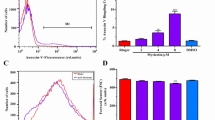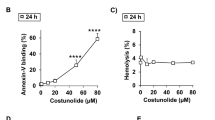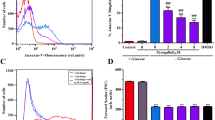Abstract
Betulinic acid (BA), a compound isolated from the bark of white birch (Betula pubescens), was reported to induce apoptosis in many types of cancer through mitochondrial dysfunction with low side effects in normal cells. Because of these features, BA is regarded as a potential anti-cancer agent. However, the effect of BA on the induction of cell death in human erythrocytes remains unknown. Given that BA is a mitochondrial toxin and mitochondria are the central cell death regulator, we hypothesized that BA is unable to elicit apoptosis (also known as eryptosis or erythroptosis) in human erythrocytes devoid of mitochondria. This study therefore tried to determine the in vitro effect of BA on the induction of eryptosis/erythroptosis. Contrary to our prediction, BA caused phosphatidylserine externalization, increase in cellular Ca2+ ion concentration ([Ca2+]i) and eryptosis/erythroptosis in human erythrocytes with a lethal dose larger than that in cancer lines. Mechanistically, the rise of [Ca2+]i seems not to be the only key mediator in the BA-mediated eryptosis/erythroptosis because depletion of external Ca2+ and use of Ca2+ channels blockers could not eliminate the BA’s effect. Also, BA was able to elicit discocyte–echinocyte transformation and release calcein from the RBC ghosts in a way similar to digitonin through membrane permeabilization. Collectively, we report here for the first time that BA induced eryptosis/erythroptosis in human erythrocytes through Ca2+ loading and membrane permeabilization.








Similar content being viewed by others
Abbreviations
- AIF:
-
Apoptosis-inducing factor
- BA:
-
Betulinic acid
- [Ca2+]i :
-
Intracellular free calcium ion concentration
- Hb:
-
Hemoglobin
- MDR:
-
Multi-drug resistance
- PS:
-
Phosphatidylserine
- RBCs:
-
Red blood cells
- TRPC:
-
Transient receptor potential cation channel
References
Alakurtti S, Makela T, Koskimies S, Yli-Kauhaluoma J (2006) Pharmacological properties of the ubiquitous natural product betulin. Eur J Pharm Sci 29(1):1–13
An X, Salomao M, Guo X, Gratzer W, Mohandas N (2007) Tropomyosin modulates erythrocyte membrane stability. Blood 109(3):1284–1288
Arias M, Quijano JC, Haridas V, Gutterman JU, Lemeshko VV (2010) Red blood cell permeabilization by hypotonic treatments, saponin, and anticancer avicins. Biochim Biophys Acta 1798(6):1189–1196
Bhavsar SK, Gu S, Bobbala D, Lang F (2011) Janus kinase 3 is expressed in erythrocytes, phosphorylated upon energy depletion and involved in the regulation of suicidal erythrocyte death. Cell Physiol Biochem 27(5):547–556
Brecher G, Bessis M (1972) Present status of spiculed red cells and their relationship to the discocyte–echinocyte transformation: a critical review. Blood 40(3):333–344
Ehrhardt H, Fulda S, Fuhrer M, Debatin KM, Jeremias I (2004) Betulinic acid-induced apoptosis in leukemia cells. Leukemia 18(8):1406–1412
Enzenmuller S, Gonzalez P, Karpel-Massler G, Debatin KM, Fulda S (2013) GDC-0941 enhances the lysosomal compartment via TFEB and primes glioblastoma cells to lysosomal membrane permeabilization and cell death. Cancer Lett 329(1):27–36
Esparis-Ogando A, Zurzolo C, Rodriguez-Boulan E (1994) Permeabilization of MDCK cells with cholesterol binding agents: dependence on substratum and confluency. Am J Physiol 267(1 Pt 1):C166–C176
Fantin VR, Berardi MJ, Scorrano L, Korsmeyer SJ, Leder P (2002) A novel mitochondriotoxic small molecule that selectively inhibits tumor cell growth. Cancer Cell 2(1):29–42
Ferraresi R, Troiano L, Pinti M et al (2008) Resistance of mtDNA-depleted cells to apoptosis. Cytom A 73(6):528–537
Foller M, Feil S, Ghoreschi K et al (2008a) Anemia and splenomegaly in cGKI-deficient mice. Proc Natl Acad Sci USA 105(18):6771–6776
Foller M, Huber SM, Lang F (2008b) Erythrocyte programmed cell death. IUBMB Life 60(10):661–668
Foller M, Sopjani M, Koka S et al (2009) Regulation of erythrocyte survival by AMP-activated protein kinase. FASEB J 23(4):1072–1080
Fulda S, Friesen C, Los M et al (1997) Betulinic acid triggers CD95 (APO-1/Fas)- and p53-independent apoptosis via activation of caspases in neuroectodermal tumors. Cancer Res 57(21):4956–4964
Fulda S, Scaffidi C, Susin SA et al (1998) Activation of mitochondria and release of mitochondrial apoptogenic factors by betulinic acid. J Biol Chem 273(51):33942–33948
Galgon T, Wohlrab W, Drager B (2005) Betulinic acid induces apoptosis in skin cancer cells and differentiation in normal human keratinocytes. Exp Dermatol 14(10):736–743
Gao MH, Cheung KL, Lau IP et al (2012) Polyphyllin D induces apoptosis in human erythrocytes through Ca2 + rise and membrane permeabilization. Arch Toxicol 86(5):741–752
Gatidis S, Zelenak C, Fajol A et al (2011) p38 MAPK activation and function following osmotic shock of erythrocytes. Cell Physiol Biochem 28(6):1279–1286
Gonzalez P, Mader I, Tchoghandjian A et al (2012) Impairment of lysosomal integrity by B10, a glycosylated derivative of betulinic acid, leads to lysosomal cell death and converts autophagy into a detrimental process. Cell Death Differ 19(8):1337–1346
Harrison HE, Bunting H, Ordway NK, Albrink WS (1947) The pathogenesis of the renal injury produced in the dog by hemoglobin or methemoglobin. J Exp Med 86(4):339–356
Hoffman JF (1958) Physiological characteristics of human red blood cell ghosts. J Gen Physiol 42(1):9–28
Hoffman JF, Tosteson DC, Whittam R (1960) Retention of potassium by human erythrocyte ghosts. Nature 185:186–187
Jilani K, Lang F (2013) Ca-dependent suicidal erythrocyte death following zearalenone exposure. Arch Toxicol 87(10):1821–1828
Khalil-Manesh F, Venkataraman K, Samant DR, Gadgil UG (1987) Effects of diltiazem on cation transport across erythrocyte membranes of hypertensive humans. Hypertension 9(1):18–23
Lang F, Qadri SM (2012) Mechanisms and significance of eryptosis, the suicidal death of erythrocytes. Blood Purif 33(1–3):125–130
Lang F, Gulbins E, Lerche H, Huber SM, Kempe DS, Foller M (2008) Eryptosis, a window to systemic disease. Cell Physiol Biochem 22(5–6):373–380
Lang F, Gulbins E, Lang PA, Zappulla D, Foller M (2010) Ceramide in suicidal death of erythrocytes. Cell Physiol Biochem 26(1):21–28
Lang E, Jilani K, Zelenak C et al (2011) Stimulation of suicidal erythrocyte death by benzethonium. Cell Physiol Biochem 28(2):347–354
Lang E, Qadri SM, Lang F (2012) Killing me softly—suicidal erythrocyte death. Int J Biochem Cell Biol 44(8):1236–1243
Lieber MR, Steck TL (1982a) A description of the holes in human erythrocyte membrane ghosts. J Biol Chem 257(19):11651–11659
Lieber MR, Steck TL (1982b) Dynamics of the holes in human erythrocyte membrane ghosts. J Biol Chem 257(19):11660–11666
Lieber MR, Steck TL (1989) Hemolytic holes in human erythrocyte membrane ghosts. Methods Enzymol 173:356–367
Lim HWG, Wortis M, Mukhopadhyay R (2002) Stomatocyte–discocyte–echinocyte sequence of the human red blood cell: evidence for the bilayer-couple hypothesis from membrane mechanics. Proc Natl Acad Sci USA 99(26):16766–16769
Liu J, Xiao N, DeFranco DB (1999) Use of digitonin-permeabilized cells in studies of steroid receptor subnuclear trafficking. Methods 19(3):403–409
Lui JC, Wong JW, Suen YK, Kwok TT, Fung KP, Kong SK (2007) Cordycepin induced eryptosis in mouse erythrocytes through a Ca2 + -dependent pathway without caspase-3 activation. Arch Toxicol 81(12):859–865
Mahmud H, Foller M, Lang F (2009) Arsenic-induced suicidal erythrocyte death. Arch Toxicol 83(2):107–113
Mullauer FB, Kessler JH, Medema JP (2009a) Betulin is a potent anti-tumor agent that is enhanced by cholesterol. PLoS ONE 4(4):e1. doi:10.1371/journal.pone.0005361
Mullauer FB, Kessler JH, Medema JP (2009b) Betulinic acid induces cytochrome c release and apoptosis in a Bax/Bak-independent, permeability transition pore dependent fashion. Apoptosis 14(2):191–202
Mullauer FB, Kessler JH, Medema JP (2010) Betulinic acid, a natural compound with potent anticancer effects. Anticancer Drugs 21(3):215–227
Neuzil J, Dong LF, Rohlena J, Truksa J, Ralph SJ (2013) Classification of mitocans, anti-cancer drugs acting on mitochondria. Mitochondrion 13(3):199–208
Prausnitz MR, Corbett JD, Gimm JA, Golan DE, Langer R, Weaver JC (1995) Millisecond measurement of transport during and after an electroporation pulse. Biophys J 68(5):1864–1870
Raghuvar Gopal DV, Narkar AA, Badrinath Y, Mishra KP, Joshi DS (2005) Betulinic acid induces apoptosis in human chronic myelogenous leukemia (CML) cell line K-562 without altering the levels of Bcr-Abl. Toxicol Lett 155(3):343–351
Reiner T, Parrondo R, De Las Pozas A, Palenzuela D, Perez-Stable C (2013) Betulinic acid selectively increases protein degradation and enhances prostate cancer-specific apoptosis: possible role for inhibition of deubiquitinase activity. PLoS ONE 8(2):e56234
Reinhart WH, Chien S (1987) Echinocyte–stomatocyte transformation and shape control of human red blood cells: morphological aspects. Am J Hematol 24(1):1–14
Schmidt ML, Kuzmanoff KL, Ling-Indeck L, Pezzuto JM (1997) Betulinic acid induces apoptosis in human neuroblastoma cell lines. Eur J Cancer 33(12):2007–2010
Schulz I (1990) Permeabilizing cells—some methods and applications for the study of intracellular processes. Methods Enzymol 192:280–300
Seeman P (1967) Transient holes in the erythrocyte membrane during hypotonic hemolysis and stable holes in the membrane after lysis by saponin and lysolecithin. J Cell Biol 32(1):55–70
Sheetz MP, Singer SJ (1974) Biological membranes as bilayer couples. A molecular mechanism of drug-erythrocyte interactions. Proc Natl Acad Sci USA 71(11):4457–4461
Spivak JL, Gascon P, Ludwig H (2009) Anemia management in oncology and hematology. Oncologist 14(Suppl 1):43–56
Thron CD (1964) Hemolysis by Holothurin a, Digitonin, and Quillaia Saponin: estimates of the required cellular lysin uptakes and free lysin concentrations. J Pharmacol Exp Ther 145:194–202
Tian YM, Li JH, Cai MJ et al (2013) High resolution imaging of mitochondrial membranes by in situ atomic force microscopy. RSC Adv 3(3):708–712
Toogood PL (2008) Mitochondrial drugs. Curr Opin Chem Biol 12(4):457–463
Wang F, Ogasawara MA, Huang P (2010a) Small mitochondria-targeting molecules as anti-cancer agents. Mol Aspects Med 31(1):75–92
Wang HD, Hao X, Shan YP, Jiang JG, Cai MJ, Shang X (2010b) Preparation of cell membranes for high resolution imaging by AFM. Ultramicroscopy 110(4):305–312
Wong P (1999) A basis of echinocytosis and stomatocytosis in the disc–sphere transformations of the erythrocyte. J Theor Biol 196(3):343–361
Yang L, Andrews DA, Low PS (2000) Lysophosphatidic acid opens a Ca(++) channel in human erythrocytes. Blood 95(7):2420–2425
Yogeeswari P, Sriram D (2005) Betulinic acid and its derivatives: a review on their biological properties. Curr Med Chem 12(6):657–666
Zuco V, Supino R, Righetti SC et al (2002) Selective cytotoxicity of betulinic acid on tumor cell lines, but not on normal cells. Cancer Lett 175(1):17–25
Acknowledgments
Minghui Gao is supported by the Hong Kong PhD Fellowship Scheme (PF09-06613).
Conflict of interest
The authors report no conflict of interest. No writing assistance was utilized in the production of this manuscript.
Author information
Authors and Affiliations
Corresponding author
Rights and permissions
About this article
Cite this article
Gao, M., Lau, P.M. & Kong, S.K. Mitochondrial toxin betulinic acid induces in vitro eryptosis in human red blood cells through membrane permeabilization. Arch Toxicol 88, 755–768 (2014). https://doi.org/10.1007/s00204-013-1162-x
Received:
Accepted:
Published:
Issue Date:
DOI: https://doi.org/10.1007/s00204-013-1162-x




